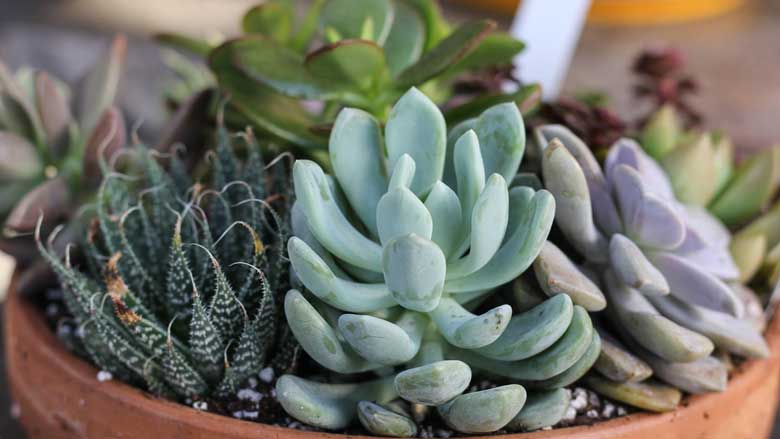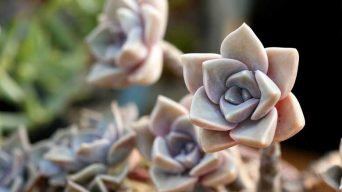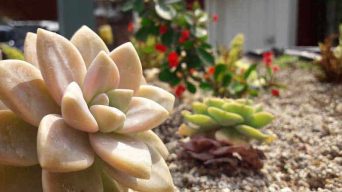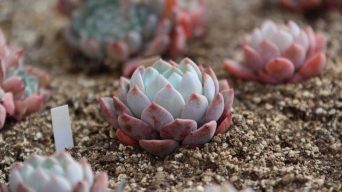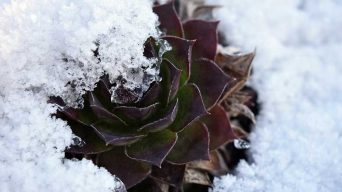There are many types of succulents to choose from, ranging from small, low-maintenance varieties like Aloe Vera to more exotic types like Echeveria. You can easily find the perfect succulents to decorate your home and add a touch of greenery to any room.
But how long do succulents live? And how can you keep them thriving for as long as possible?
Succulents have varying lifespans depending on the species, but with proper care, including adequate light, water, and soil, they can live for many years, sometimes even decades, making them excellent additions to any living room.
This article will answer all your questions about succulent lifespans and provide tips on keeping them healthy and vibrant for years to come.
Average Lifespan of Succulents
Succulents have a lifespan of three to twenty years, with the majority living between five and ten years. However, some species, like the Saguaro cactus, can live for over 200 years.
The average lifespan of a succulent plant is determined by several factors, including:
- The succulent species
- The growing conditions
- The amount of care and attention the plant receives
Lifespan of Common Succulent Varieties
There are many different species of succulents, and each one has a different lifespan.
It’s hard to give an exact number for how long each succulent species will live, depending on the factors mentioned above.
However, we can give a rough estimate based on the average lifespan of common succulent species:
- Echeveria: 5 to 25 years
- Haworthia: 5 to 20 years
- Aeonium: 3 to 10 years
- Sempervivum (Hens and Chicks): 1 to 3 years
- Crassula (Jade Plant): 70 to 100 years
- Kalanchoe: 6 to 7 years
- Aloe vera: 5 to 25 years
- Living Stones: 40 to 50 years
- Saguaro Cactus: 150 to 200 years
- Barrel Cactus: 50 to100 years
As you can see, the lifespan of a succulent can vary greatly depending on the species.
The average lifespan of most succulents is between five and ten years, but some can live for much longer.
The lifespan of a succulent can be affected by a variety of elements, such as the species, the environment, the amount of sunlight, the amount of water, and the type of soil it is planted in.
Succulents grown in optimal conditions will typically have a longer life than those that are not.
The amount of care and attention a succulent receives is also significant in how long it lives.
Gardening is an important skill to have when it comes to caring for plants, as proper gardening techniques can help ensure that plants are given the best possible care and attention, which in turn can help extend their lifespan significantly.
Lifespan of Indoor Succulent Plants
With the right care, succulents can thrive indoors and enjoy a long and healthy lifespan.
Although some have been known to live much longer, most indoor succulents will live between five and ten years.
With the right conditions and care, your indoor succulents could be a part of your home for decades to come.
Growing succulents indoors has some advantages and disadvantages.
One of the most significant advantages is that you can control the environment your succulents are in.
This means you can create a warm, humid climate for tropical succulents or dry, cool weather for cacti and other desert succulents.
One of the disadvantages of growing succulents indoors is that you may not have enough natural light.
If you don’t have a lot of windows in your home, or if they face the wrong direction, you may need to supplement your succulents’ light with grow lights.
How To Keep Indoor Succulents Alive
To ensure the survival of your indoor succulents, you should provide them with the right conditions and care.
Here are some tips:
- Place your succulents in a sunny spot near a window. Provide bright indirect light if possible.
- Water your succulents when the potting soil is dry to the touch. Avoid getting water on the leaves to prevent rot.
- Use a well-draining potting mix as a cactus soil mix or succulent mix.
- Use a pot with a drainage hole to avoid waterlogging.
- Repot your succulents every two years or when they become root-bound.
- Protect your succulents from drafts, heaters, and air conditioners.
- Keep an eye out for pests and diseases. Treat them immediately if you see any signs.
By providing your houseplants with the appropriate amount of light, water, and nutrients and ensuring they are in a well-ventilated space, you can guarantee that your indoor succulents will remain healthy and thrive for many years to come.
Lifespan of Outdoor Succulents
If you’re growing succulents outdoors, they can live for many years.
The average lifespan of an outdoor succulent is approximately five to ten years. However, certain types of succulents can thrive for up to 20 years or more.
One of the advantages of growing succulents outdoors is their ease of care. They require minimal water and fertilizer and can tolerate a broad range of temperatures. However, there are some considerations to keep in mind.
Pests are one concern; succulents are susceptible to mealybugs, aphids, and other issues.
Weather is another factor. Succulents cannot endure extreme cold or heat, so it’s essential to ensure they’re protected from frost and sunburn.
Proper sun exposure is crucial for these plants to thrive. Place them in an area that receives at least six hours of direct sunlight a day for optimal growth. However, excessive direct sunlight can harm the plant, causing leaves to burn and the plant to dehydrate.
If the plant is situated in an area with too much direct sunlight, it’s important to provide some shade or a filter to shield it from excessive sun exposure. This can be achieved by using shade cloth, relocating the plant to a partially shaded area, or utilizing other structures such as umbrellas or awnings.
Humidity is another factor to consider when planting in the garden. High humidity can cause fungal diseases, while low humidity can cause plants to dry out quickly. To help manage humidity levels, try to plant in areas with good air circulation.
How To Keep Outdoor Succulents Alive
In order to keep your succulents alive outdoors, you need to be aware of the environmental conditions they require, such as adequate sunlight, proper drainage, and the right temperature.
Make sure to provide them with the best possible environment to ensure their health and longevity.
Some tips for caring for outdoor succulents include:
- Make sure they get enough sunlight. Succulents need at least six hours of sunlight, preferably in the morning or late afternoon.
- Water them deeply but infrequently. Succulents need about an inch of water per week, but it’s best to wait until the soil is dry before watering them again.
- Protect them from frost and extreme weather conditions. In cold climates, you’ll need to bring your succulents indoors during winter; in hot climates, you’ll need to provide shade during the hottest part of the day.
- Make sure they’re in a well-draining soil mix. Succulents need soil that drains quickly to prevent root rot.
- Fertilize them once a month during the growing season. Use a succulent fertilizer or diluted all-purpose fertilizer.
By following these tips, you can keep your outdoor succulents alive for many years to come.
Succulents Without Sunlight: How Long Can They Live?
Succulents can live many years without sunlight, but they won’t thrive and look unhealthy.
Succulents need at least four hours of sunlight a day to grow and thrive, so if you’re growing them indoors, make sure they’re near a window.
If you don’t have a lot of sunlight available, you can grow succulents in partial shade. They won’t grow as fast or flower as often and will not be as vibrant as those grown in full sun, but they will still add a variety of colors to your garden, ranging from deep greens to bright purples and pinks.
You may need to supplement your succulent light with grow lights in very low light conditions (less than four hours of direct sunlight per day).
On the other hand, succulents may survive without direct sunshine only if they are grown in soil. If the plant is grown in water, it will not survive long without direct sunlight.
Some signs that your succulents are not getting enough sunlight include:
- Stretching towards the light
- Pale leaves
- Slow growth
- Fewer flowers
If you see these signs, move your succulents to a location with more sunlight.
With proper care, your succulents can live for many years, regardless of how much sunlight they’re getting.
But if you want them to thrive, make sure they’re getting at least four hours of direct sunlight each day.
Keeping Succulents Thriving in Low Light
If you don’t have a lot of sunlight available, there are still ways you can keep your succulents alive.
Here are some tips for growing succulents in low light:
- Choose the right type of succulent. Some succulents are more tolerant of low light than others.
- Put them in a bright spot, but not in direct sunlight. A sunny windowsill is ideal, but if you can’t provide that much light, try an east- or north-facing window.
- Use grow lights to supplement their light. If you have a few succulents, you can use a desk lamp with a fluorescent bulb; if you have a lot of succulents, you may need to invest in a grow light.
- Water succulents sparingly. They don’t need a lot of water, so only water them when the soil feels dry to the touch.
- Fertilize them occasionally. Use a succulent fertilizer or diluted all-purpose fertilizer.
Succulents are an excellent choice for low-light conditions, but they still need some light to survive.
If you can’t provide enough natural light, supplement their light with grow lights.
With proper care, your succulents can live for many years in low-light conditions.
Succulents Without Soil: Can They Survive?
Succulents can survive for long periods without soil.
They can be grown in water or in a hydroponic system.
The plant’s roots will absorb all of the nutrients and moisture that they need from the water.
This can be an excellent option for those who want to have low-maintenance plants.
The growth rate of succulents can be affected if they are grown in water, as they will not grow as quickly or flower as often as they would in soil, resulting in a lower-maintenance plant.
They may also be more susceptible to pests and diseases.
Ensuring Succulents Thrive Without Soil
If you don’t have soil available, there are still ways you can keep your succulents alive.
Growing succulents in water is one option, but you can also grow them in a hydroponic system.
In a hydroponic system, the plant’s roots will absorb all the nutrients and moisture they need from the water.
If you choose to grow your succulents in water, ensure the water is changed regularly, and the roots are not allowed to dry out.
Also, succulents grown in water may be more susceptible to pests and diseases.
Succulents can live for many years without soil, but they won’t grow as fast or flower as often. If you want your succulents to thrive, growing them in soil is best.
Succulents in Cold Weather: How Long Can They Endure?
Succulents can tolerate cold weather conditions but won’t thrive in low temperatures. They may die if exposed to freezing temperatures for extended periods.
Cold-hardy succulents can endure freezing temperatures but won’t necessarily thrive in cold weather conditions.
So, how long can succulents survive in cold weather? It depends on the type of succulent and the severity of the cold weather.
Some succulents are more cold-hardy than others and can endure freezing temperatures for short periods. However, prolonged exposure to extreme cold weather can harm most succulents and significantly reduce their lifespan.
Cold-hardy succulents such as Sempervivum, Sedum, and Agave can survive and continue to thrive in cold climates. Depending on the species, these succulents can endure temperatures as low as -20°F (-29°C) or lower.
On the other hand, many popular indoor succulents like Echeveria and Aloe vera are more sensitive to cold temperatures. They are native to warm climates and cannot survive prolonged exposure to freezing temperatures.
In colder regions, these succulents are often grown as houseplants or moved indoors during winter to protect them from the cold.
Maintaining Succulents in Cold Climates
During the cold winter months, succulents may enter a period of dormancy, where they stop growing and become dormant until the weather warms up again. However, they can still be grown indoors if kept in a warm, bright, and well-ventilated area.
There are a few things you need to do to make sure your succulents survive the winter months:
- Place your succulents in a sunny location, such as a south-facing window.
- Make sure your succulents are not overwatered. Succulents do not need a lot of water, so you only need to water them when the soil is dry.
- Bring your succulents indoors if the temperature outside drops below freezing.
- If you cannot bring your succulents indoors, wrap them in a frost blanket or place them in a protected area.
- Do not place your succulents in a drafty area near a door or window.
- Ensure your succulents are not in direct sunlight if you keep them indoors. Succulents can sunburn if they are exposed to too much sunlight.
- Check on your succulents regularly to ensure they are not experiencing any problems.
Succulents are a type of plant that can be grown in various climates.
If you live in an area with mild cold weather, you can still grow succulents by placing them in a sunny location and protecting them from frost.
If you live in an area with cold weather, you can still grow succulents by keeping them indoors.
With the proper care, succulents can live for many years.
Final Thoughts
So, how long do succulents live? On average, succulents will live between three and twenty years.
However, some species can live much longer with the proper care and attention.
By providing your succulent plants with the right growing conditions and care, you can help to ensure they reach their maximum life expectancy and live a long and healthy life.
While succulents can live for many years, they may not always look their best.
As time passes, the leaves of succulents might gradually change in color, turning yellow or brown, while the stem could lose its strength and become fragile.
At this point, giving your succulent a little extra TLC is essential to help it stay healthy and happy.
If you’re looking for a plant that will last a lifetime, succulents are a great option.
With proper care, these plants can thrive for years, adding a touch of beauty to your home.

